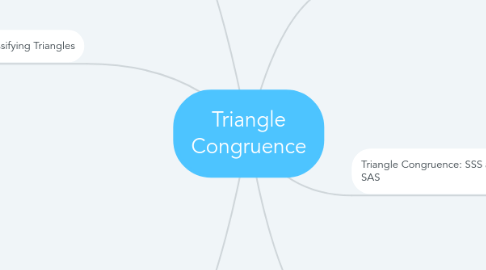
1. Congruence and Transformations
1.1. dilation
1.1.1. the action or condition of becoming or being made wider, larger, or more open.
1.2. isometry
1.2.1. An isometry is a transformation that preserves length, angle measure, and area. Because of these properties, an isometry produces an image that is congruent to the preimage.
1.3. rigid transformation
1.3.1. A rigid transformation is another name for an isometry.
2. Classifying Triangles
2.1. acute triangle
2.1.1. Three acute angles (less than 90°)
2.2. equiangular triangle
2.2.1. Three congruent angles (angles 60°)
2.3. right triangle
2.3.1. One right angle (90°)
2.4. obtuse triangle
2.4.1. One obtuse angle (greater than 90°)
2.5. equilateral triangle
2.5.1. Three congruent sides
2.6. isosceles triangle
2.6.1. At least two congruent sides
2.7. scalene triangle
2.7.1. No congruent sides
3. Angle Relationships in Triangles
3.1. auxiliary line
3.1.1. An auxiliary line is a line that is added to a figure to aid in a proof.
3.2. corollary
3.2.1. An auxiliary line is a line that is added to a figure to aid in a proof.
3.3. interior
3.3.1. The interior is the set of all points inside the figure.
3.4. exterior
3.4.1. The exterior is the set of all points outside the figure.
3.5. interior angle
3.5.1. An interior angle is formed by two sides of a triangle.
3.6. exterior angle
3.6.1. An exterior angle is formed by one side of the triangle and extension of an adjacent side.
3.7. remote interior angle
3.7.1. A remote interior angle is an interior angle that is not adjacent to the exterior angle.
4. Congruent Triangles
4.1. corresponding angles
4.1.1. Corresponding angles and corresponding sides are in the same position in polygons with an equal number of sides.
4.2. corresponding sides
4.3. congruent polygons
4.3.1. Two polygons are congruent polygons if and only if their corresponding sides are congruent.
5. Triangle Congruence: SSS and SAS
5.1. triangle rigidity
5.1.1. The property of triangle rigidity gives you a shortcut for proving two triangles congruent.
5.2. included angle
5.2.1. An included angle is an angle formed by two adjacent sides of a polygon.
6. Triangle Congruence: ASA, AAS, and HL
6.1. included side
6.1.1. An included side is the common side of two consecutive angles in a polygon.

